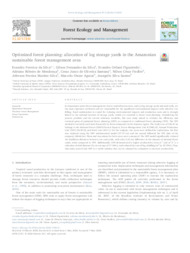Optimized forest planning: allocation of log storage yards in the Amazonian sustainable forest management area.
Optimized forest planning: allocation of log storage yards in the Amazonian sustainable forest management area.
Author(s): SILVA, E. F. da; SILVA, G. F. da; FIGUEIREDO, E. O.; MENDONÇA, A. R. de; SANTANA, C. J. de O.; FIEDLER, N. C.; SILVA, J. P. M.; AGUIAR, M. O.; SANTOS, J. S.
Summary: In Amazonian native forest management, forest road infrastructures, such as log storage yards and skid trails, arethe most expensive attributes and are responsible for the significant environmental impacts with selective treefelling. Road optimization is crucial for reducing environmental impacts and production costs and is stronglylinked to the optimal location of storage yards, which are essential to forest road planning. Considering thepresent problem and the current solutions available, this case study aimed to evaluate the efficiency andeventual gains of optimized forest planning (OFP), as compared to traditional forest planning (TFP). The TFPmethod is currently used most frequently by forest companies in the Amazon region. The study area of 126.41 habelongs to the National Forest (NAFO) Saracá-Taquera, Forest Management Unit II (FMU-II), Annual ProductionUnit (APU) 04/2018, and Work Unit (WU) 2. For the analysis, two areas were defined for exploration: thefirstwas explored using the OFP mathematical model (57.75 ha) and the second followed the TFP plan of thecompany (68.66 ha). Plans and executions for both areas were compared. The OFP model significantly reducedthe Euclidean distances between tree and yards, with only 0.23 km difference in the amount of planned forestroads, when compared to TFP. Additionally, OFP demonstrated a higher productivity (trees.h-1and m3.h-1), areduction of skid distance (by an average of 17.16%), and reduced the cost of log skidding (m3 by 25.76%). Thus,this study proved that OFP is a viable solution that can be adopted by companies to increase productivity.
Publication year: 2020
Types of publication: Journal article
Unit: Embrapa Acre
Observation
Some of Embrapa's publications are published as ePub files. To read them, use or download one of the following free software options to your computer or mobile device. Android: Google Play Books; IOS: iBooks; Windows and Linux: Calibre.
Access other publications
Access the Agricultural Research Database (BDPA) to consult Embrapa's full library collection and records.
Visit Embrapa Bookstore to purchase books and other publications sold by Embrapa.

